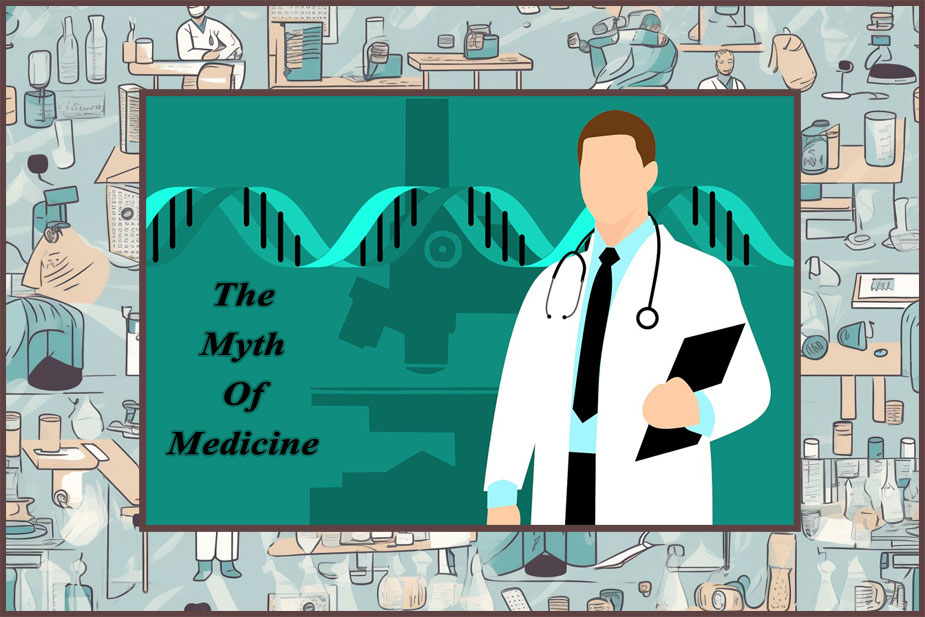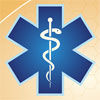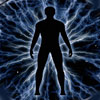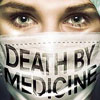The Myth Of Medicine
 by Herbert M. Shelton
by Herbert M. Shelton
What most distinguishes medicine in the twentieth century from medicine in the preceding centuries is its burgeoning into a giant industry. Particularly the pharmaceutical and hospital industries have grown to gigantic proportions during this century. At the same time medicine has donned the bright robes of science and has succeeded in hypnotizing mankind with the illusion that it is a scientific evocation. With its great show of research and its vast array of statistics, which are made to order, today’s medicine fools the unwary into believing that, with its stronger poisons, it achieves successes which the past hardly dared dream of.
In its issue of December 31, 1910, The Lancet (London), is an article entitled “The Annus Medicus,” which said: “That medicine has advanced during the last twelve months, we have no doubt, though the time is too early to pick upon any given piece of recorded work and point to it as the beginning of a new principle or the embryo of a method of treatment with which great things will be wrought.”
That is an echo of a day when progress was not so rapid. Today, medicine makes such rapid advances that new pieces of work and new discoveries are evaluated almost before they emerge from the womb of the laboratory. Nobody seems to think that “the time is too early” to judge the worth or the lasting qualities of a new alleged discovery. Today there is such a hurry to cash in on every new notion and every new drug that great advances are born and die in rapid succession. New principles are promulgated, great expectations are raised; then they pass; new methods of treatment are born, are heralded to an expectant world with a fanfare of trumpets, and then pass to oblivion almost before the ink is dry on the newspapers that carry the glad tidings. The medical harvest is barren but the field is full of tares.
Sir William Osier described the treatment of disease from Hippocrates to John Hunter as “one long traffic in hypotheses,” a description that does not touch the anti-vital character of the substances and processes employed in treatment. Osier, who was regarded as the greatest physician of his time, also failed to note that the traffic in hypotheses did not cease with the birth of John Hunter, but continued right on to the end of the eighteenth century, through the whole of the nineteenth century and is still with us today. Between Hunter and Osier there was the great French physician, Broussias. No informed man will deny the truth of the statement of Broussias that up to his time “medicine has only landed men in chimerical hope, and taken all in all, it has been more harmful than useful to mankind.”
What many of them will seek to deny, however, is the assertion, which I now make, that the further extension of the poisoning practice that has taken place since the time of Broussias, has not been more useful, than was the practice before his time.
Medicine was a craft based on superstition and faulty empirical observations. If, today, we think of it as an applied science, because of the great amount of research and analyses that have been done, this is because we fail to discern that the old superstitions are still ensconced in the modem theories and practices. Modem medicine is still demon-haunted, although it has altered the sizes and shapes of its demons. Indeed, they have migrated from the world of ectoplasm to that of protoplasm, but they are still with us.
The Renaissance represented a resurgence of long-buried elements of Greco-Roman civilization in the emancipation of Europe from churchly repressions and asceticism. Each generation since the Renaissance has seen a deepening of the misconceptions of medicine, a gross widening of the anti-vital horizon, a more profound elaboration of fallacy and a more complex formulation of hypothetical schemes that have no reality in the world of life. The object of all medical research seems to be nothing more basic than the effort to discover how each manifestation of impaired health can be solved by artificial means.
We frequently hear of the progress of medicine during the past half century, but the story is a list of near-discoveries and forgotten practices. As an example, medical treatment of smallpox has been so variable and changeable that no adequate consideration can be given here. It has varied from heating and stimulating measures to the very opposite plan of cooling and debilitating the patient. Half a century ago calomel and colocynth, senna and salts, saline cathartics, castor oil, opiates and blisters were generally recommended and employed. All plans utterly failed to benefit the patients, all of them doing much injury and killing great numbers of patients.
By continually harping upon the subject, the medical industry has the public convinced that the results of their experiments are dependable, and so brainwashed has the public become that it forgets the latest flop from the medical laboratory in reading the announcement of the newest thriller. Controlled experiments are called the “scientific method,” but we are not to overlook the fact that there are many sources of error in such experiments. The controlled experiment is nothing but the old trial and error method of testing our guesses. It is a program of trying and trying again. Sir John Hunter, whose famous advice to Edward Jenner, “Don’t think, try,” helped to fasten the vaccination practice upon mankind, was largely responsible for the adoption by the medical profession of the deceptive device called the controlled experiment.
Sound (as opposed to logical) reasoning presupposes correct premises and when it is realized that the medical system lacks a single verifiable premise, it becomes apparent that all of its conclusions are false and all of its practices are fatal. Realizing its total lack of a single verifiable principle, the profession eagerly grasps the control experiment in the hope that this would provide them with a way out of their dilemma. Controls, to mean anything, must receive no drug treatment of any kind. From the viewpoint of the regular physician, they must be totally neglected, so far as so-called therapeutics care is concerned. Not only the controls, but the patients receiving the new drug to be tested must be numerous, else will the results not be dependable. A few cases are not enough to establish the virtue of an alleged remedy. The preceding animal experiments combined with the clinical testing of the new drug not only fails to detect all of the evil effects of the new drug, but it fails to reveal all of its shortcomings. As a consequence of these limitations, the final experiment must be made upon numerous patients in what amounts to a general practice. Years sometimes elapse before all the evils produced by a drug become known.
The holocaust that resulted from prescribing thalidomide for pregnant mothers after it had been “thoroughly tested” in animals and in the clinic, is an example of a drug the evil effects of which quickly become apparent. Aspirin may be cited as an example of a drug that was in use for a long time before its evil results began to be recorded and studied. It is now well established that the taking of aspirin is a cause of gastrointestinal bleeding and it is said that aspirin makes an appreciable contribution to the number of hospital admissions on account of such bleeding. Bleeding caused by aspirin frequently results in gastric ulcer and anemia. The outcome of this knowledge is that people with gastric and duodenal ulcers are cautioned against the taking of aspirin. But even here there are specially coated tablets that are advised. The profession is kept forever busy trying to either cure or prevent the evil results of its remedies. Complications are built by drugs.
The most important source of error in interpreting the results of the controlled experiments is the tendency to attribute to the new drug recoveries that are due to the self-healing powers of the body. A hundred different new drugs tested on people suffering with the common cold would all apparently cure the cold, whereas we know that the cold spontaneously ends in a few days with or without treatment. All new cures ride to glory on the self-healing powers of the body. Failure to take this fact into account causes these experimenters to delude themselves about the value of every new drug they test. Popular ignorance of the body’s self-healing powers permits the public to be duped over and over again by the alleged wonder cures. Let us have light! Medical experimentation can exist only in the darkness of ignorance.
The same mistake is made in compiling statistics. Statistics show results, not causes. A compilation of statistics may show that eighty percent of those treated with a new drug recovered health, but when we know that these recoveries were the results of the operation of the body’s own self-healing power and are not due to the drug, we interpret the statistics quite differently. It is not illogical to say that twenty percent of those treated by the new drug were killed by it.
Physicians are afflicted with a “statistical fever” although failing to recognize that their statistics are very misleading and commonly have to be scrapped a few weeks after they are published. How often does it happen that a man gathers up a lot of case reports and arranges these into statistics and publishes these only to have someone else publish another series of statistics at the same time or shortly thereafter which show his figures to be unreliable. If statistics were of real value, there is hardly a cure of the past that would not still be in favor. Yet we get great numbers of people who have been told that they have cancer, tuberculosis, Bright’ s disease, and other incurable maladies, who are convinced they have these diseases, but whom, we were convinced, did not suffer with the troubles they were declared to have. It would be no task at all to get testimonials from these people asserting that they were cured of these diseases, but we never ask for such testimonies, for we believe they would be as misleading as those offered the public by the medical profession. Rarely does the profession publish a testimonial—instead it publishes “case reports” and statistics. It should be obvious to my readers that a case report is no better than the diagnosis upon which it is based and that statistics are not better than the diagnoses that went into their making. The greater the number going into the statistics, the greater the number of mistaken diagnoses.
Physicians themselves are often deceived by plausibly prepared testimonials in the form of statistics, case reports and reports of research results. As long ago as 1933, T. Swann Harding, writing in the June issue of The Modern Thinker about the employment by physicians of patent medicines, wrote: “Doctors who bemoan the public’s gullibility are themselves equally gullible. And their gullibility is far more dangerous. Yet the manufacture and sale of fake medicines which doctors prescribe could be stopped. Why is so obvious and necessary a step neglected?” For this and many similar utterances, Mr. Harding, author and research scientist, was persona non-grata with the medical powers-that-were. To dull his pen, they finally had to resort to the expediency of making him editor of a medical journal.
Physicians are not more immune to persuasion, even conviction, by the cleverly prepared advertising of the drug houses than are laymen. Guided by testimonials, faked reports, clever salesmen (detail men), colored advertisements in the medical journals, and by the attitude of the Council on Pharmacy and Chemistry of his medical association, the physician accepts and prescribes worthless and harmful drugs. Mr. Harding correctly says that full page advertisements in ten colors on heavy paper carried in leading medical journals fail to establish the clinical value of any given pharmaceutical product, nor is therapeutic efficiency increased by fancy wrappings. He says that regardless of the display of scientific investigation made by the various drug companies, the truth remains that the chief interest of the drug trade lies in manufacture and distribution (that is in profits), and that at best, scientific research is to be looked upon as merely a means to an end.
The general public has been led to believe that physicians have remedies for every passing phase of impairment of health, but the physicians have no such faith in their remedies. Sir William Osier once said of his credulity: “For the crass therapeutic credulity so widespread today, and upon which our manufacturing wax fat, there is no more potent antidote than the healthy skepticism bred of long study in the postmortem room.” Truly has it been remarked that the postmortem room is the disillusion chamber of the thoughtful physician, for postmortem revelations of the effects of treatment shatter his faith in his remedies.
A profession that frequently admits that it does not know what to do for the common cold, that does not know how to remedy a simple indigestion or an uncomplicated constipation, that is helpless before a crop of pimples on the face of a teenage girl, should hesitate to herald its many alleged cures for more formidable and complex pathologies to the world. A profession that does not have an average life span equal to the general average should not talk of increasing human life. When its greatest specialists often sicken and die of the very diseases in which they specialize, there is assuredly something wrong, both with their theories of causation and with their means of prevention and cure. When medical experts sicken and die of the very diseases in which they specialize, when the best physicians in the country have no more protection against disease than the layman, when medical men of high and low degree lose health and die prematurely in spite of their high national and international reputations, what is a medical education worth? An education that is inferior to instinct does not deserve to be continued.
The present is preeminently the era of adverse reactions and iatrogenic disease. The medicine of our time is based on destructive and not on constructive methods. With such methods of treatment, have we any right to expect other than adverse effects? Why can’t the profession develop at least one cure that won’t kill the patient? Just one—that would be a start in the right direction. Yet one reads drug advertising with a sense that death must be an error on the part of the consumer. It is necessary to keep the patient goggled with prismatic lenses through which he can see only what it is desired that he see. A glimpse of light causes him to rebel and look elsewhere for recovery.
Medicine, as practiced today, as thousands are beginning to suspect, is of uncertain benefit. Certainly, physicians are having daily evidences of its hurtfulness shoved under their noses. If we could gather together the many thousands now living who have been under medical care for periods ranging from six months to several years and who have received no apparent benefit from the care, we would have a huge army. Another army could be composed of those who have ample reason to think that they have been seriously injured by medical care. All of this, when added together, is enough to damn the whole profession. But we have another army to add to the list: there is the great army of prematurely dead who have died because of the failure and evils of medical care.
Can it be that this is medical science? What is science, if it is not the discovered truth about anything? Science is not a so-called exceptional truth; it is not a truth that works today and fails tomorrow. A means of care, such as penicillin, that is heralded as a great wonder cure today and that turns in a crop of glaring failures tomorrow cannot be based on science. Forget the excuses of failure; the alibis and pretexts. Take into account that the drug is not living up to the promises made for it.
Dr. Harry Clements, writing in Health For All (London) November 1961 quotes: “Dr. Speedby, in The 20th Century and Your Heart: ‘Now, thanks to prevention inoculation, chemotherapy and the use of antibiotics, such diseases as diphtheria, scarlet fever and pneumonia have lost their terrors’.
“Report by Robert Scott Thomson in the British Medical Journal, July 29, 1961: ‘. . .the reduction in the case fatality of scarlet fever began long before the introduction of chemotherapy or antibiotics’.
“Dr. Speedby: ‘Hospitalization and special clinics for the treatment of venereal diseases are becoming unnecessary. Curiously enough, even the germs themselves have changed their characteristics and nature since being confronted with penicillin and other antibiotics’.
“Editorial in The Lancet, July 29, 1961: ‘Evidence from many countries indicates that the incidence of gonorrhea is increasing and that remedies which have proved effective in the recent past are losing some of their efficacy’.”
What one may think of medical practices depends upon what medical authority or medical report one reads. Medical opinion has always been both fluid and contradictory. The authorities are rarely able to agree among themselves. At medical conventions, where the big men of the profession get together and swap delusions and pat each other on the back, each physician has a right to put into circulation almost any exaggeration about himself and get his conceits polished up for the coming year. We tend to defend a thing merely because it is in vogue. Physicians tend to defend the current fashions in drugs while scoffing at the drugs that may have been fashionable a decade before.
There are those who think that the body can be affected for good by a manipulation of its actions and reactions. If the body is subjected to some influence that occasions a particular action, it must, in the nature of things, react. They interpret these actions and reactions as being equivalent to the natural healing processes, an interpretation that is not only false, but one that leads to exhausting treatment. There is no limit to the possibility of exploiting this idea that the series of actions and reactions occasioned by treatment are equivalent to the natural healing process. When we find gnat bites offered as a means of making tiny openings in the skin through which toxins may be expelled, we cannot guffaw lest we regurgitate.
Medicine as practiced today is a system of spectacular palliation. Physicians are satisfied to relieve pain, reduce fever, check a cough, allay irritability, check a diarrhea, relieve a headache or otherwise tranquilize the sufferer. They administer sedatives and stimulants with no thought given to the causes of the troubles for which their ill-advised doses are prescribed. Instead of studying cause and effect, they search for cures and for more effective palliatives or palliatives that produce fewer adverse reactions. The deceptive fallacy of the present day medical advocate of the “safe small dose,” which has been accepted by the greater part of our people leads into the abyss.
Cures are often found and they remain cures for a week or two or a year or two, rarely for a decade. Many cures for tuberculosis have been discovered and new cures for the disease are frequently announced, but the case rate continues high and people continue to die of tuberculosis. Cure mongers pretend to be able to set aside the laws of nature and to be able to cure a disease without even knowing its cause. This is happening over and over before our eyes in the case of cancer. The Cancer Society heralds the glad tidings to the world that seventy thousand cases of cancer are being cured in this country every year—all this without knowing the cause of cancer. This is an example of what is meant by curing. To cure is to restore health without removing the cause that has impaired it.
The great variety of drugs in the pharmacopoeia serves more as a medium for the display of ignorance than as an opportunity for correct selection. When every patient is given the same drug for the same disease without any regard for the variations in the causative factors in different cases, we reach the height of ridiculousness. Equally ridiculous is the practice of the profession of testing each new cure as it is discovered upon a wide variety of so-called diseases, a practice which attests to the fact that the old alchemical search for a panacea is still on. That the practice persists is a certain indication that the profession is lacking understanding. The great and complex system of medicine that has been twenty-five hundred years in the building is going to pieces and no man can put it back together again.
The preventive measures of twentieth century medicine, like legacies from the past, along with its cures, are all disease producing. In the eighteenth century, medicine adopted the old shamanistic practice of inoculating the healthy with pus from pustules on the body of smallpox patients to prevent smallpox. After nearly a hundred years cowpox pus was substituted for smallpox pus and vaccination replaced variolation. Until the coming of Pasteur with his germ theory of causation, only the vaguest ideas were entertained about how vaccination was supposed to work. Pasteur laid the ground work for the discovery of hundreds of preventative vaccines and sera, only a few of which survived the initial test. Today we have a thoroughly Pasteurized profession, so preposterous, so filled with quackery and imposture, so blinded by its own conceit which impels it to attempt to force its inoculating practices upon everyone that it has become a menace to the public health. It was once suggested by a prominent British London physician that “the glorification of Pasteur is a sign of the decadence of medicine,” but it is difficult to conceive of medicine decaying.
We are in rebellion against the vile superstition of the age that by inoculating into the bodies of the healthy the products of disease of animals or of another human being, the healthy can be insured against disease. Our position is simply this, that far from preventing disease, every attack of this kind upon the integrity of the organism makes it more liable to the development of disease.
Good health is considered dangerous only by those who believe in and want to force upon everybody the vaccination practices that have been developed by the medical profession. It has been our observation that it is the vaccinated and inoculated who are afraid. Sure of their protection, they are afraid of the unprotected. If you are not vaccinated you are a menace to the vaccinated.
Were the theory upon which the vaccination practice is based a valid one, a successful re-vaccination would indicate susceptibility to smallpox. William Scott Tebb also pointed out that in the years when smallpox is prevalent, the total or general mortality is less than the average, indicating a salutary effect growing out of the epidemic.
That the demoralizing influence of “infection” scares is well understood by those in authority and they do not hesitate to use this as a means of getting done what they want done. To first frighten the wits out of the people and get them to comply with their orders is the pattern of activity.
After years of trying to find a germ for each disease and turning up but a small handful, viruses were conjured into existence to save the tottering germ theory. Against viruses the conventional vaccines and serums were ineffective. Something different is needed. Result! A new type of vaccine is in the offing. The New Scientist, July 13, 1961 says: “It looks as if interferon, which is produced by the cells to deal with virus infection may be a very general response of the cells of vertebrates to virus infection and that interferon is capable of blocking the multiplication of virtually all the animal viruses that have been tested to date.” The next thing will be to find means of stimulating the production of interferon and a way to “safely” inject the production of one animal into the body of another.
W. McDermott, who is described as a foremost American authority on the subject, wrote: “A surprising proportion of the disease load in our hospitals today is microbial disease, but, unlike those of a few decades ago, today’s diseases are caused by the very microbes that we have long been accustomed to regard as essentially harmless inhabitants of our tissues … In short, man is beginning to fall prey to what we have hitherto regarded as his ‘own’ microbes.” It is now the medical view that microbes that were formerly harmless have been transformed into pathogenic bacteria by antibiotics and other drugs used in combating microbes previously held responsible for diseases. Assuredly, this is the climax of stupidity!
Excerpt from The Myth Of Medicine
See Part II here.
Posted in Health, Other Topicswith comments disabled.





